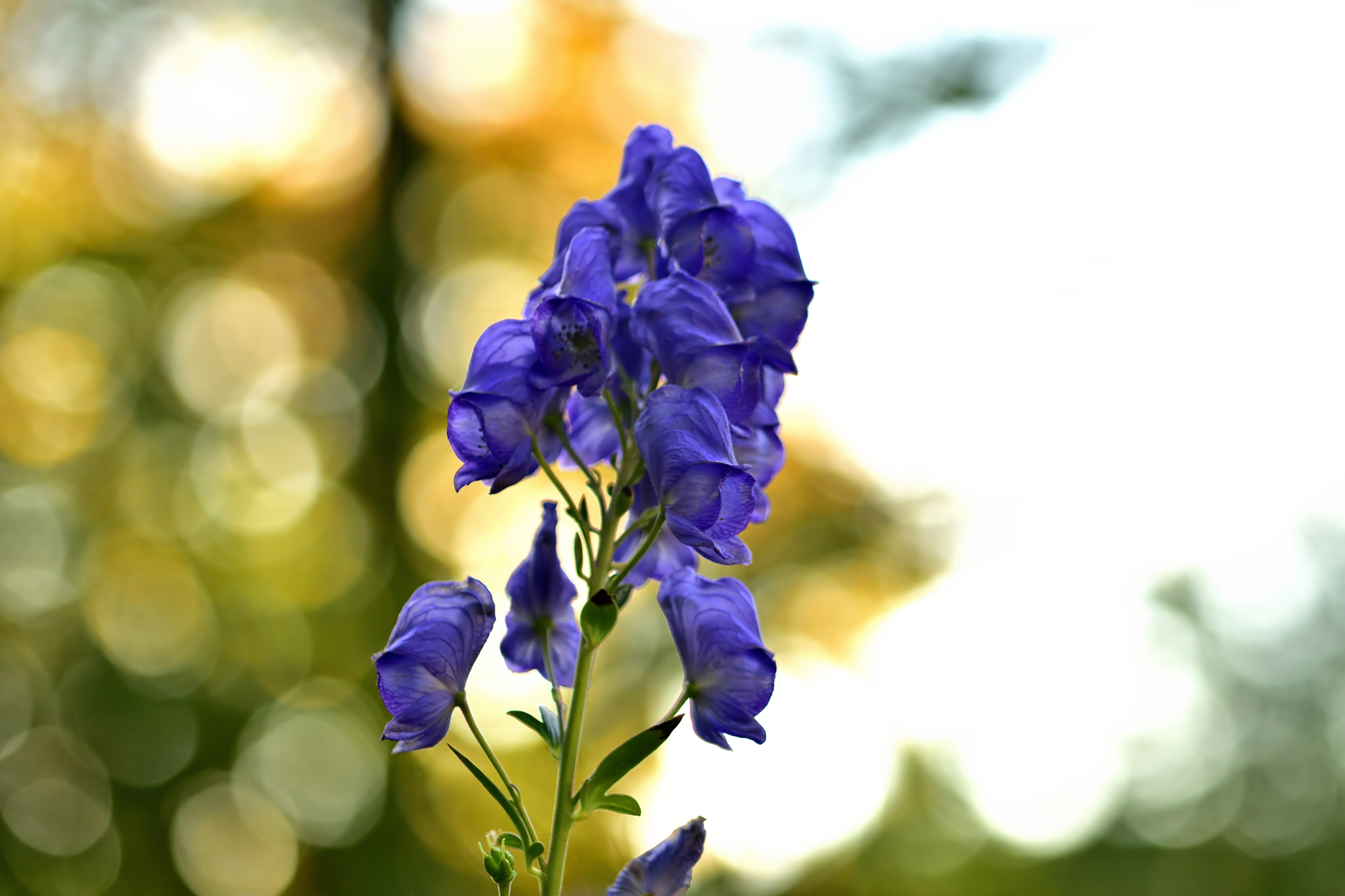Common monkshood is a perennial herb belonging to the genus aconitum and family Ranunculaceae. It is native to Europe and North America; introduced to Australia, New Zealand and parts of East Asia, where it is considered invasive because it has displaced native plants.
It is also known as wolfsbane, old wives hood, soldiers helmet, dogs bane, devils hood, devils helmet, blue rocket, mousebane, queen of poisons, and aconite.
It is one of the most poisonous plants in the world, and is a potent neurotoxin that can be fatal if ingested.
Identification
Aconitum napellus (monkshood) is of a small size, with dark green leaves and deep blue flowers at the top of each long and erect stem. Sometimes instead of blue, you may come across white or yellow flowers instead.
Its flowers are arranged in a whorl of three, with the sepals and petals spreading in opposite directions at ground level, the stamens butting up against the circle of petals.
Finally, monkshood can look very similar to several non-toxic plants such as foxglove, making identification important. It is vital to note that there are several types of monkshood aconitum plants with different toxicity levels which could lead to accidental death if the wrong type is handled or ingested.

Where Does Monkshood Grow?
Monkshood is native to Western and Central Europe (Britain and Northern Europe), North America (Canada and the United States), Northern Asia (Siberia), Japan, Korea, Scandinavia (Sweden) and New Zealand. It has also been introduced into Australia.
It grows in mountain meadows throughout the northern hemisphere between 1000 – 3000 m above sea level and can handle both full sun and afternoon shade. In the UK, it is a rare and declining plant.

What’s In The Name?
People often ask, “What is the difference between monkshood and wolfsbane?”
Well, there is no difference. Aconitum napellus goes by many different names, and each one of them has its own history with this notorious plant:
- It used to be called wolf’s bane because of its use by shepherds for protection against wolves, who would mix the ground root into meaty bait for wolves to protect their livestock from the hated animals.
- The name “fool’s parsley” comes from the belief that only a fool would eat this plant.
- “Monkshood” refers to the shape of its flower, which resembles a hood worn by medieval monks.
- The name “devil’s helmet” comes from the poisonous nature of monkshood.
- The generic name “aconitum” derives from the Greek word akon, which means dart or javelin, in reference to its spear-shaped leaves. Due to its severe toxicity, monkshood was used as poison for arrow tips by the Romans and Greeks during ancient times.
- The specific name “napellus” is derived from Latin and means “little turnip”.
- Monkshood flowers are also believed to have been worn by early Christian hermits as protection from animal attacks because of their strong odour, which repels many insects and small animals.
Is Monkshood Poisonous To Humans?
All parts of the monkshood plant are poisonous to humans and livestock, especially the roots and seeds. However, it is both deer and rabbit resistant.
Monkshood contains two groups of chemicals known as alkaloids: aconitine and aconine. Aconitine is approximately 12 times more toxic than aconine and is considered to be the most potent neurotoxin that occurs naturally in plants. Other sources list it as 1,000 times more potent than strychnine.
Monkshood poisoning can occur when the plant is ingested or even by absorption through the skin or mucous membranes; contact should be avoided at all costs. Exposure to monkshood can be fatal even in small amounts, though the antidote found in ergot may be effective in treating monkshood poisoning.
The root of the plant contains calcium oxalate crystals known as raphides. These crystals can cause intense irritation if they come into contact with the skin or inside your mouth, so it’s best not to put the root in your mouth.
So, what happens if you touch monkshood? It can ultimately lead to death. If you must handle it, wear gloves before breaking the plant into pieces; wash your hands immediately after handling any part of this plant.

Symptoms Of Monkshood Poisoning
These toxins can cause nausea, severe vomiting; difficulty breathing; irregular heart rate; excessive salivation; hallucinations, blurred vision, delirium, and convulsions; coma; and death if not treated immediately. When contact with the skin occurs, irritation may occur along with rashes or blisters in severe cases.
Treatment For Monkshood Poisoning
If you believe that you or someone else has ingested monkshood, call your local poison control centre, and if in the UK, contact 999 right away. Treatment often involves inducing vomiting to get rid of what remains in the stomach if possible. Activated charcoal may also be given to inhibit absorption of the toxin by the gastrointestinal tract.

The Final Word
As you can see, this plant may not be as safe as you once thought. At the very least, make sure you do not confuse this highly toxic plant with other plants if you must handle it! But I would recommend you stick to other plants unless you’re incredibly knowledgeable about the subject.
Additional Resources
Sources and References
- Aconitum napellus(Monkshood): A Purple Poison – poison.org
- Monkshood – aacc.org
Sam loves to learn about animals and their habitats. He has been a nature lover from a very young age, and has been writing papers and articles about wildlife for as long as he can remember.

Thank you for that. I just unknowingly bought 5 bare roots. I will not be planting them. Why are we allowed to buy such a dangerous plant?